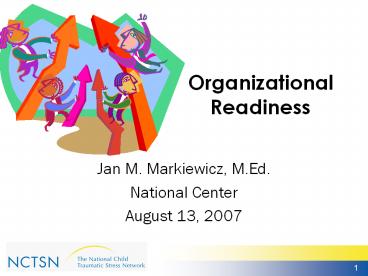Organizational Readiness - PowerPoint PPT Presentation
1 / 5
Title:
Organizational Readiness
Description:
Participants will be able to identify the rationale for evaluating readiness ... Closing the Quality Chasm in Child Abuse Treatment: Identifying and ... – PowerPoint PPT presentation
Number of Views:86
Avg rating:3.0/5.0
Title: Organizational Readiness
1
Organizational Readiness
- Jan M. Markiewicz, M.Ed.
- National Center
- August 13, 2007
2
Learning Objectives
- Participants will be able to identify the
rationale for evaluating readiness - Participants will be able to describe key
questions to assess readiness
3
Is Your Organization Ready to Change?
- Conduct an honest assessment of
organizational readiness. - An objective, concrete organizational
assessment should be conducted and should involve
staff at all levels, to get multiple
perspectives. Such an assessment can help
identify barriers to the implementation of EBPs
or new practices early on and provide a better
understanding of the roles and responsibilities
of different personnel in the implementation
process.
Keep in mind that organizations tend to
overestimate their readiness in self-assessments!
4
Key Questions in Assessing Your
OrganizationThese questions represent key issues
to consider when changing practice within an
organization. The targeted areas are ones that
might be considered deal breakers if not
considered in the planning stage.
- Clients
- Are clients screened for trauma-related symptoms
that could qualify them for the new practice? - Leadership/Clinicians/Staff
- Does the agency and clinical leadership actively
support the adoption of the new practice for
reasons clinicians can understand and share? - Supervision
- Are supervisors prepared to learn about the new
practice through training, careful study of the
literature, and consultation with experts?
- Internal and External Stakeholders
- Has information been collected from key
stakeholders within the agency (e.g. intake,
records, and billing personnel) that might be
affected by the new practice? - Program/Culture/Services
- Have measurement systems been developed to
provide feedback on the progress in adoption of
the new practice? - Finance and Administration
- Will current reimbursement practices cover the
new practice? - Education
- Do therapists have adequate time to formally
learn about the new practice?
5
Additional Information, Help, or Resources
- Jan Markiewicz, Training Director
- jan.markiewicz_at_duke.edu
- Allred, C., Markiewicz, J., Amaya-Jackson, L.,
Putnam, F., Saunders, B., Wilson, C., Kelly, A.,
Kolko, D., Berliner, L., Rosch, J. (2005). The
Organizational Readiness and Capacity Assessment.
Durham NC UCLA-Duke National Center for Child
Traumatic Stress. - Fixsen, D., Naoom, S., Blase, K., Friedman, R.,
Wallace, F. (2005). Implementation Research A
Synthesis of Literature. Tampa, FL Louis de la
Parte Florida Mental Health Institute. - Kauffman Best Practices Final Report. (2004).
Closing the Quality Chasm in Child Abuse
Treatment Identifying and Disseminating Best
Practices. Kauffman Foundation PA.































